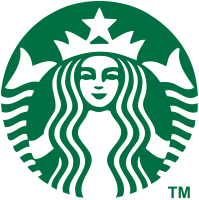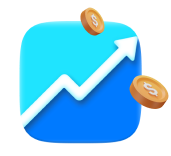- Chart
- Upturn Summary
- Highlights
- Revenue
- Valuation
 Upturn AI SWOT
Upturn AI SWOT - About
Starbucks Corporation (SBUX)

- BUY Advisory
- SELL Advisory (Profit)
- SELL Advisory (Loss)
- Profit
- Loss
- Pass (Skip investing)
 Stock price based on last close
Stock price based on last close (see disclosures)
- ALL
- 1Y
- 1M
- 1W
Upturn Advisory Summary
12/03/2025: SBUX (1-star) is currently NOT-A-BUY. Pass it for now.
1 Year Target Price $94.19
1 Year Target Price $94.19
| 9 | Strong Buy |
| 6 | Buy |
| 18 | Hold |
| 0 | Sell |
| 1 | Strong Sell |
Analysis of Past Performance
Type Stock | Historic Profit -16.66% | Avg. Invested days 40 | Today’s Advisory PASS |
Upturn Star Rating  | Upturn Advisory Performance | Stock Returns Performance |
Key Highlights
Company Size Large-Cap Stock | Market Capitalization 99.05B USD | Price to earnings Ratio 53.44 | 1Y Target Price 94.19 |
Price to earnings Ratio 53.44 | 1Y Target Price 94.19 | ||
Volume (30-day avg) 34 | Beta 0.98 | 52 Weeks Range 73.95 - 115.04 | Updated Date 12/3/2025 |
52 Weeks Range 73.95 - 115.04 | Updated Date 12/3/2025 | ||
Dividends yield (FY) 2.88% | Basic EPS (TTM) 1.63 |
Analyzing Revenue: Products, Geography and Growth
Revenue by Products
Product revenue - Year on Year
Revenue by Geography
Geography revenue - Year on Year
Earnings Date
Report Date - | When - | Estimate - | Actual - |
Profitability
Profit Margin 4.99% | Operating Margin (TTM) 10.98% |
Management Effectiveness
Return on Assets (TTM) 7.27% | Return on Equity (TTM) - |
Valuation
Trailing PE 53.44 | Forward PE 35.21 | Enterprise Value 120025420000 | Price to Sales(TTM) 2.66 |
Enterprise Value 120025420000 | Price to Sales(TTM) 2.66 | ||
Enterprise Value to Revenue 3.22 | Enterprise Value to EBITDA 24.83 | Shares Outstanding 1137100000 | Shares Floating 1134905397 |
Shares Outstanding 1137100000 | Shares Floating 1134905397 | ||
Percent Insiders 0.18 | Percent Institutions 85.87 |
 Upturn AI SWOT
Upturn AI SWOT
Starbucks Corporation

Company Overview
 History and Background
History and Background
Starbucks Corporation was founded in Seattle, Washington in 1971. Initially selling roasted coffee beans, it expanded into coffee beverages in the 1980s under Howard Schultz's leadership. It rapidly expanded globally, becoming a ubiquitous coffeehouse chain.
 Core Business Areas
Core Business Areas
- Retail Operations: Operating company-owned and licensed stores that sell coffee, tea, food, and merchandise.
- Channel Development: Selling coffee and tea products through grocery stores, foodservice accounts, and other channels.
- International: Coffee and other beverages sold internationally, licensed and owned. Focused on growth in China.
 Leadership and Structure
Leadership and Structure
Laxman Narasimhan is the current CEO. The organizational structure is hierarchical, with regional management overseeing operations in various geographic areas.
Top Products and Market Share
 Key Offerings
Key Offerings
- Coffee Beverages: A wide variety of espresso-based drinks, brewed coffee, and iced coffee. Globally recognised. Competitors: McDonald's McCafe, Dunkin', Tim Hortons.
- Tea Beverages: Hot and iced tea, including herbal tea and flavored tea drinks. Competitors: Teavana (owned by Starbucks), Lipton, Honest Tea.
- Food Items: Pastries, sandwiches, salads, and other snacks. Competitors: Panera Bread, local cafes.
- Merchandise: Coffee beans, mugs, tumblers, and brewing equipment. Competitors: Amazon, specialized coffee equipment retailers.
Market Dynamics
 Industry Overview
Industry Overview
The coffee shop industry is highly competitive, with increasing demand for specialty coffee and convenient locations. Rapid consolidation and globalization is taking place.
Positioning
Starbucks is a global leader in the coffeehouse market, known for its premium coffee, consistent experience, and loyalty program. Competitive advantages include brand recognition, extensive store network, and supply chain.
Total Addressable Market (TAM)
The global coffee shop market is estimated to be worth over $495 billion. Starbucks is positioned well to capture a significant portion of this TAM, though competition is increasing, and expansion is becoming more difficult in Western markets.
Upturn SWOT Analysis
Strengths
- Strong brand recognition
- Extensive global store network
- Loyalty program (Starbucks Rewards)
- Established supply chain
- Consistent product quality
Weaknesses
- High prices relative to competitors
- Dependence on North American market
- Inconsistent service quality in some locations
- High employee turnover
Opportunities
- Expansion into emerging markets
- Development of new product lines (e.g., plant-based options)
- Increased focus on mobile ordering and delivery
- Partnerships with other businesses
- Growing coffee-at-home market
Threats
- Intense competition from other coffee chains and local cafes
- Fluctuations in coffee bean prices
- Changing consumer preferences
- Economic downturns
- Increased labor costs and regulations
Competitors and Market Share
 Key Competitors
Key Competitors
- DNKN
- SBUX
- YUMC
- MCD
Competitive Landscape
Starbucks has a strong brand and loyal customer base, but faces increasing competition from other coffee chains, fast-food restaurants, and independent cafes. Key competitive advantages include its extensive store network, loyalty program, and brand image. Key disadvantage is it's higher price point than McDonald's and Dunkin.
Major Acquisitions
Ethos Water
- Year: 2005
- Acquisition Price (USD millions): 8
- Strategic Rationale: Expanded Starbucks' commitment to social responsibility and provided a bottled water option.
Teavana
- Year: 2012
- Acquisition Price (USD millions): 620
- Strategic Rationale: Gained access to a premium tea brand and expanded its tea offerings. This was later written down and closed.
Growth Trajectory and Initiatives
Historical Growth: Starbucks experienced rapid growth in the 2000s and 2010s, fueled by store expansion and same-store sales growth. Growth has slowed in recent years due to market saturation in some regions.
Future Projections: Analysts project moderate revenue growth for Starbucks in the coming years, driven by international expansion and digital initiatives. EPS growth is expected to be higher, supported by cost-cutting measures and share repurchases.
Recent Initiatives: Recent initiatives include expanding in China, developing new plant-based food and beverage options, and investing in mobile ordering and delivery technologies.
Summary
Starbucks remains a powerful brand with a strong global presence. While they face increasing competition and economic challenges, the company's investments in technology and international expansion, particularly China, present opportunities for future growth. The company's high prices and reliance on the North American market could present challenges.
Similar Stocks
Sources and Disclaimers
Data Sources:
- Starbucks Investor Relations, SEC Filings, MarketWatch, Statista
Disclaimers:
The information provided is for informational purposes only and should not be considered investment advice. Market data is dynamic and may change rapidly. Past performance is not indicative of future results.
 AI Summarization is directionally correct and might not be accurate.
AI Summarization is directionally correct and might not be accurate.
 Summarized information shown could be a few years old and not current.
Summarized information shown could be a few years old and not current.
 Fundamental Rating based on AI could be based on old data.
Fundamental Rating based on AI could be based on old data.
 AI-generated summaries may have inaccuracies (hallucinations). Please verify the information before taking action.
AI-generated summaries may have inaccuracies (hallucinations). Please verify the information before taking action.
About Starbucks Corporation
Exchange NASDAQ | Headquaters Seattle, WA, United States | ||
IPO Launch date 1992-06-26 | Chairman & CEO Mr. Brian R. Niccol | ||
Sector Consumer Cyclical | Industry Restaurants | Full time employees 381000 | Website https://www.starbucks.com |
Full time employees 381000 | Website https://www.starbucks.com | ||
Starbucks Corporation, together with its subsidiaries, operates as a roaster, marketer, and retailer of coffee internationally. The company operates through three segments: North America, International, and Channel Development. Its stores offer coffee, tea, and other beverages, roasted whole beans and ground coffees, complementary food, packaged coffees, single-serve products, and ready-to-drink beverages; and various food products, such as pastries, breakfast sandwiches, and lunch items. The company also licenses its trademarks through licensed stores, and grocery and foodservice accounts. The company offers its products under the Starbucks Coffee, Teavana, Seattle's Best Coffee, Ethos, and Starbucks Reserve brands. Starbucks Corporation was founded in 1971 and is based in Seattle, Washington.

Note: This website is maintained by Upturn Corporation, which is an investment adviser registered with the U.S. Securities and Exchange Commission. Such registration does not imply a certain level of skill or training. Investing in securities has risks. Past performance is no guarantee of future returns. No assurance is provided as to any particular investment return, and you may lose money using our services. You are strongly advised to consult appropriate counsel before making any investments in companies you learn about through our services. You should obtain appropriate legal, tax, investment, accounting, and other advice that takes into account your investment portfolio and overall financial situation. You are solely responsible for conducting due diligence on a potential investment. We do not affect trades for you. You will select your own broker through which to transact. Investments are not FDIC insured, they are not guaranteed, and they may lose value. Please see the Privacy Policy, Terms of Use, and Disclosure for more information.
 Home
Home 
